Manchester City travelled to the AMEX stadium on a Saturday evening, the same location where they had lifted the title in 2019. Although Liverpool have won the Premier League, Pep Guardiola’s men are still fighting for the FA Cup and the UEFA Champions League. Therefore, the season has not ended, and the standard has to be high.
In this game, Manchester City have put five past Matthew Ryan’s goal. This tactical analysis will dissect the tactics of Graham Potter’s Brighton and Guardiola’s City.
Lineups
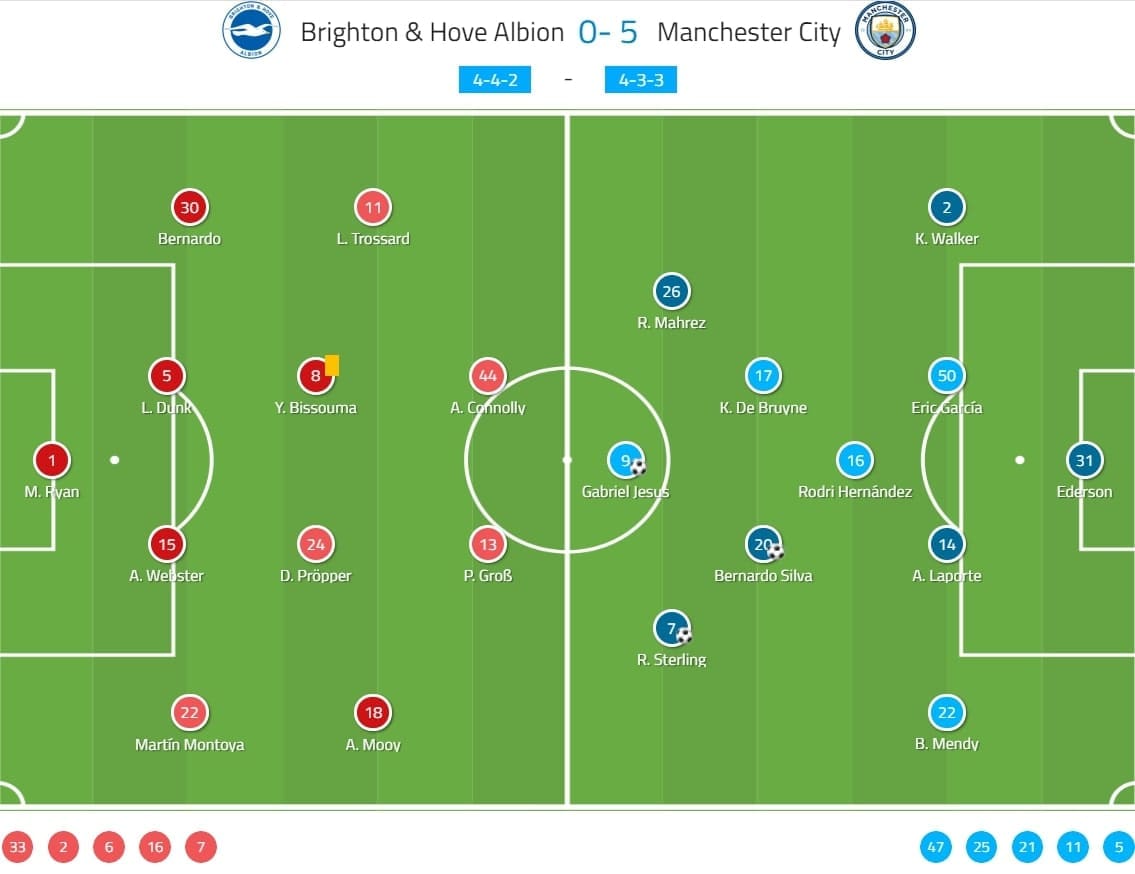
Potter’s men lined up in a 4-4-2, with the young Aaron Connolly playing with pascal Groß as the strikers. The manager rotated his team a bit by playing Martín Montoya and Bernardo as the full-backs, keeping Tariq Lamptey and Dan Burn on the bench.
City also changed the team a bit though the formation was still a 4-3-3. Raheem Sterling and Bernardo Silva returned to the squad as David Silva and Phil Foden were rested. The entire backline was not starting against Newcastle United on Wednesday, so they should be fully fit and ready for the game.
Brighton defensive style of play
Like many other teams against City, Brighton were defending by setting up a midblock and seldom pressed high. However, regardless of the intentions of Potter, the defence was not able to control and contain the attack of the opponents. The challenge intensity and aggressiveness were insufficient in general.
Before the water break, the defensive shape was roughly a 4-4-2 by keeping the wingers at the half-spaces. A numerical overload was created centrally, and this often forced the opponents to play the ball wide. However, positioning the narrow wingers also meant the opposition full-backs were uncontrolled. City often reached the final third by using these wide options as spaces were allowed by this defensive scheme.
As an example, the shape was drawn below and Kyle Walker received the ball. The left-winger of Brighton (#11 Leandro Trossard) was unable to access the English right-back quickly – the Seagulls could only shadow to cover the options. Trossard limited the central passing lane and forced Walker to play a difficult ball inward, which was read and intercepted by the defence.
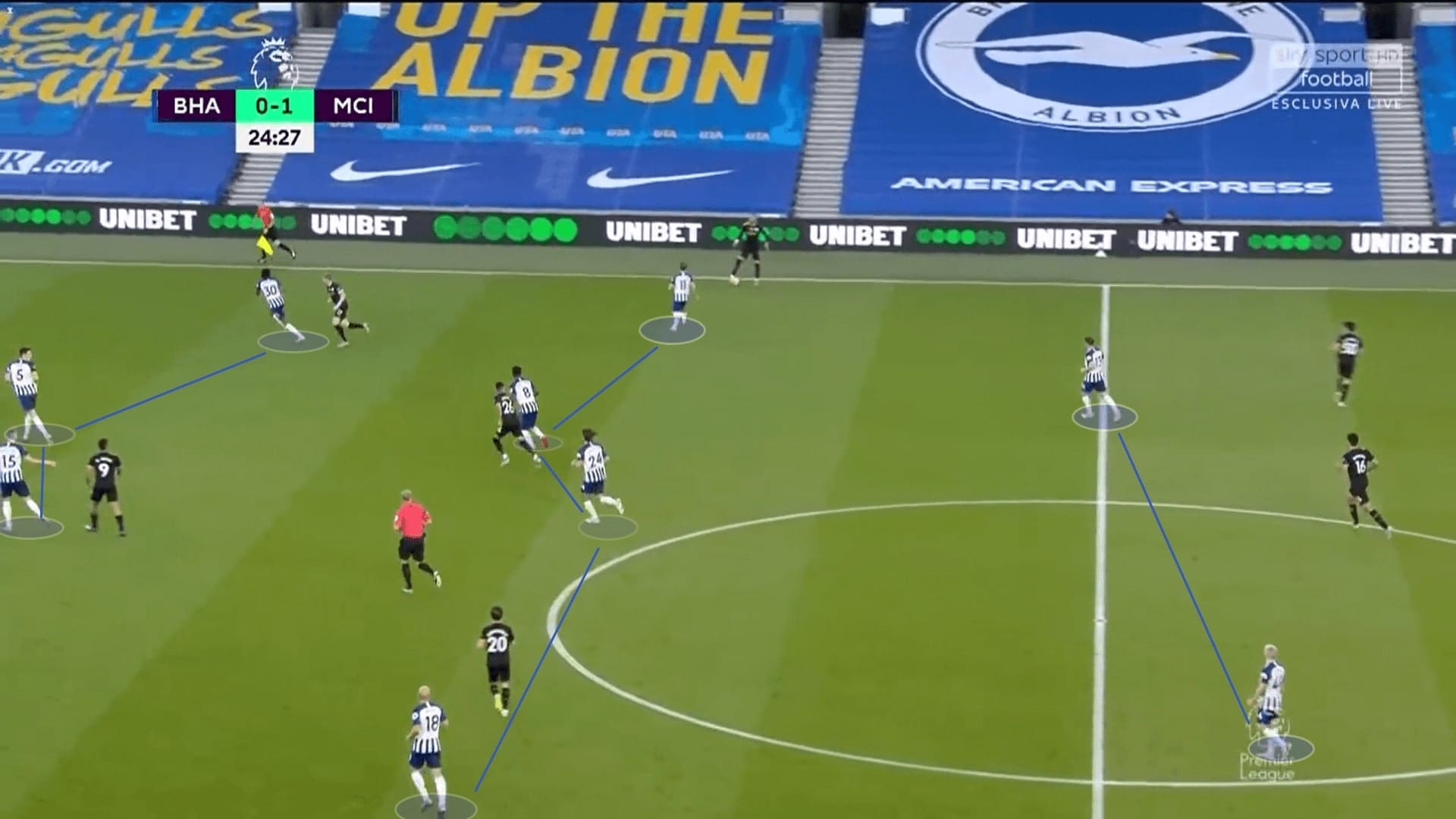
An advantage of this 4-4-2 shape was shown during the press. By leaving an advanced midfielder to the backline, Brighton could mirror the build-up shape and man-mark the opposition. The pressing often occurred in the early stages and led by either front player. The objective was to cut the connections of the centre-backs, forcing the ball to one side and close all options around the carrier.
It was executed as follows. Connolly engaged Aymeric Laporte while shadowing Eric García. Since Kevin De Bruyne was not involved in the first phase here, the Belgian international was neglected as the Brighton midfielders’ man-marked the City midfielders. Aaron Mooy was another player who provided with the defensive support, closing Benjamin Mendy and this completed the press – all ground options were covered. Laporte went for long and Brighton were quite confident to win these aerial duels, including this one.
However, this aggressive pressing style seldom appeared. The first line might lack the courage to commit men forward and apply the pressure on the centre-backs. Also, City were fluent to deal with these presses and Potter’s side remained passive.
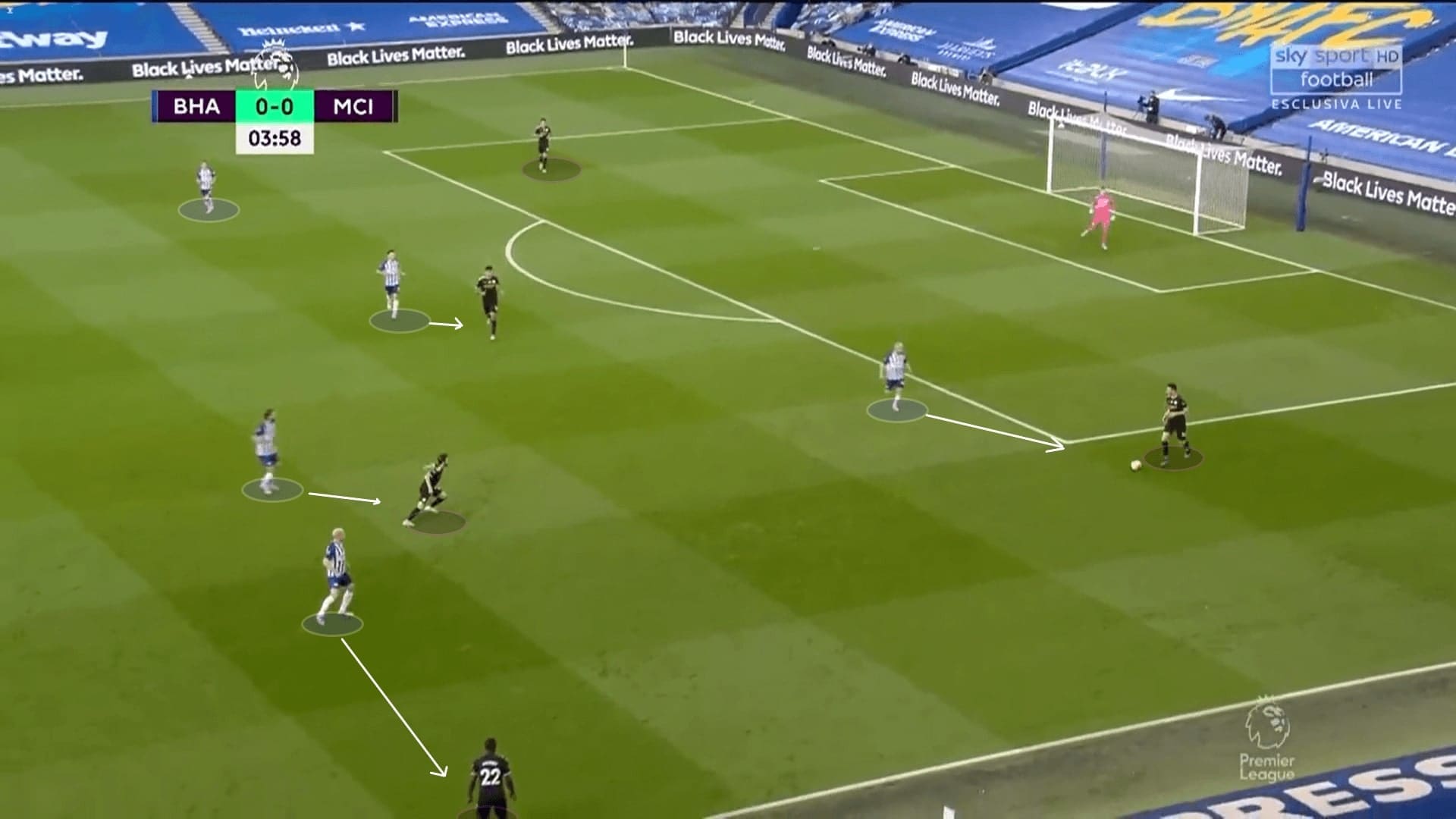
After the water break, Potter might also have noticed the loophole of the 4-4-2 system as explained in the above analysis. The Brighton winger was encouraged to move higher, so the early pressure was possible and the shape was more like a 4-3-3 afterwards.
In this image, we illustrated the new defensive structure of the Seagulls. This time, Walker was unable to progress the ball higher as Trossard was already here to pressure the right-back.
However, the structure issue of this 4-3-3 shape was also a disadvantage – the two highest lines lacked horizontal coverage. The horizontal gaps between players were huge and the passes were possible to play between two players.
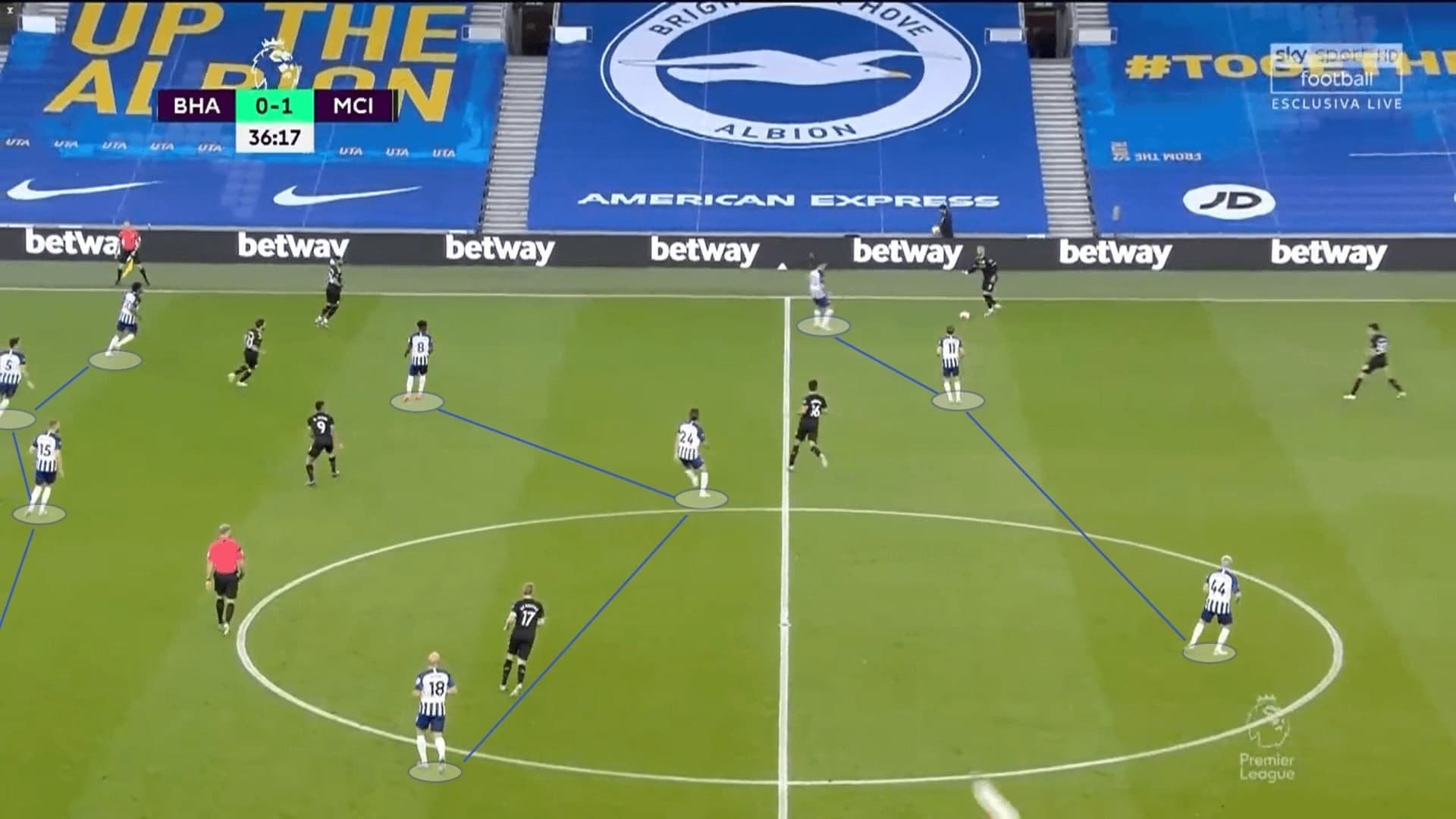
No matter what shape Potter was adopting, the issue of low challenging intensity occurred throughout the game. Against skilful and quick players such as Sterling and Riyad Mahrez, Brighton were too soft and never aggressive. The above-mentioned names always found rooms to escape from the pressure by dribbling, which made the defensive efforts in vain.
As an example, Mooy and Pröpper were double-pressing Sterling below. However, both players were not trying to force into a duel or at least prevent the target from turning. Since Mendy occupied Montoya out wide, space appeared and Sterling could turn and dribble diagonally to progress. Pröpper might be a good passer, but his leniency on Sterling had cost too much.
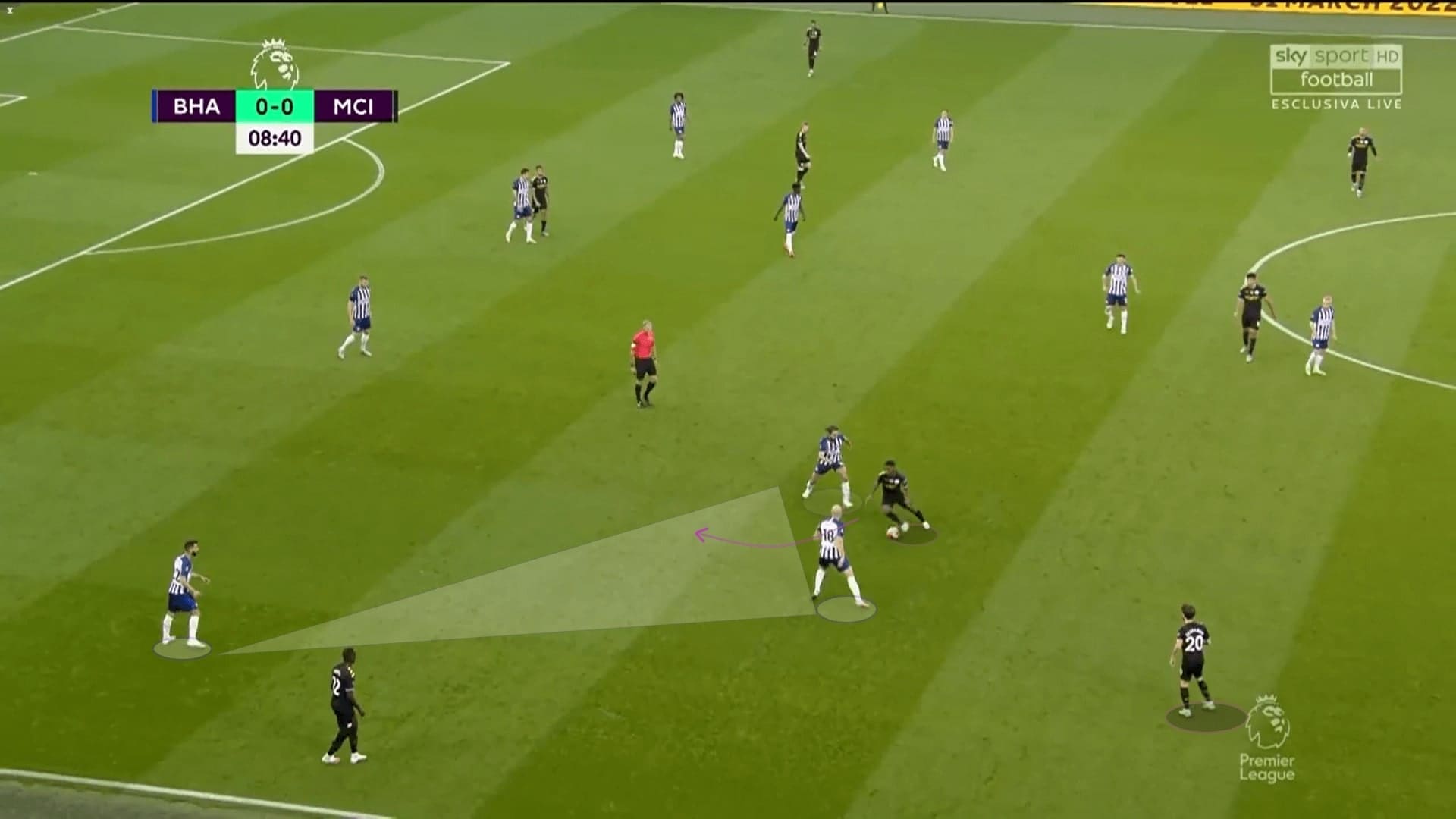
Attacking with the full-backs
In our previous analysis, we explained how City mastered several strategies to construct an attack. At the AMEX stadium, several concepts were mingled which helped Pep’s men to dominate the game and played in the way they wanted. Although Guardiola was famous for inverting the full-backs as a false midfielder, this was not the theme of this game. On the contrary, the Citizens were attacking with the full-backs out wide.
The 2-3 or 3-2 build-up shape was unchanged. When the full-backs were occupying the outer zone, the midfielders stayed deeper to form the second layer with Rodrigo Hernández. The dropping players did a brilliant job to manipulate the second line of Brighton and constructed a solid first phase.
Again, City expected Rodri was unavailable as an option because of the shadowing or man-marking. But, the Spanish pivot still served as the third player, overloading the first line of Brighton – a 3 v 2 numerical advantage was created. This meant a free player would be available to play the forward pass.
In this example, we drew the triangle created at the centre. Notice B. Silva’s positioning, it was excellent as the Portuguese player was between Pröpper and Mooy. This was a positional superiority and City used just one player to occupy two opponents. Not only did this separate the first and second lines of Brighton, but it also kept the opposition winger away from the outer zone, opening the passing lane to Mendy.
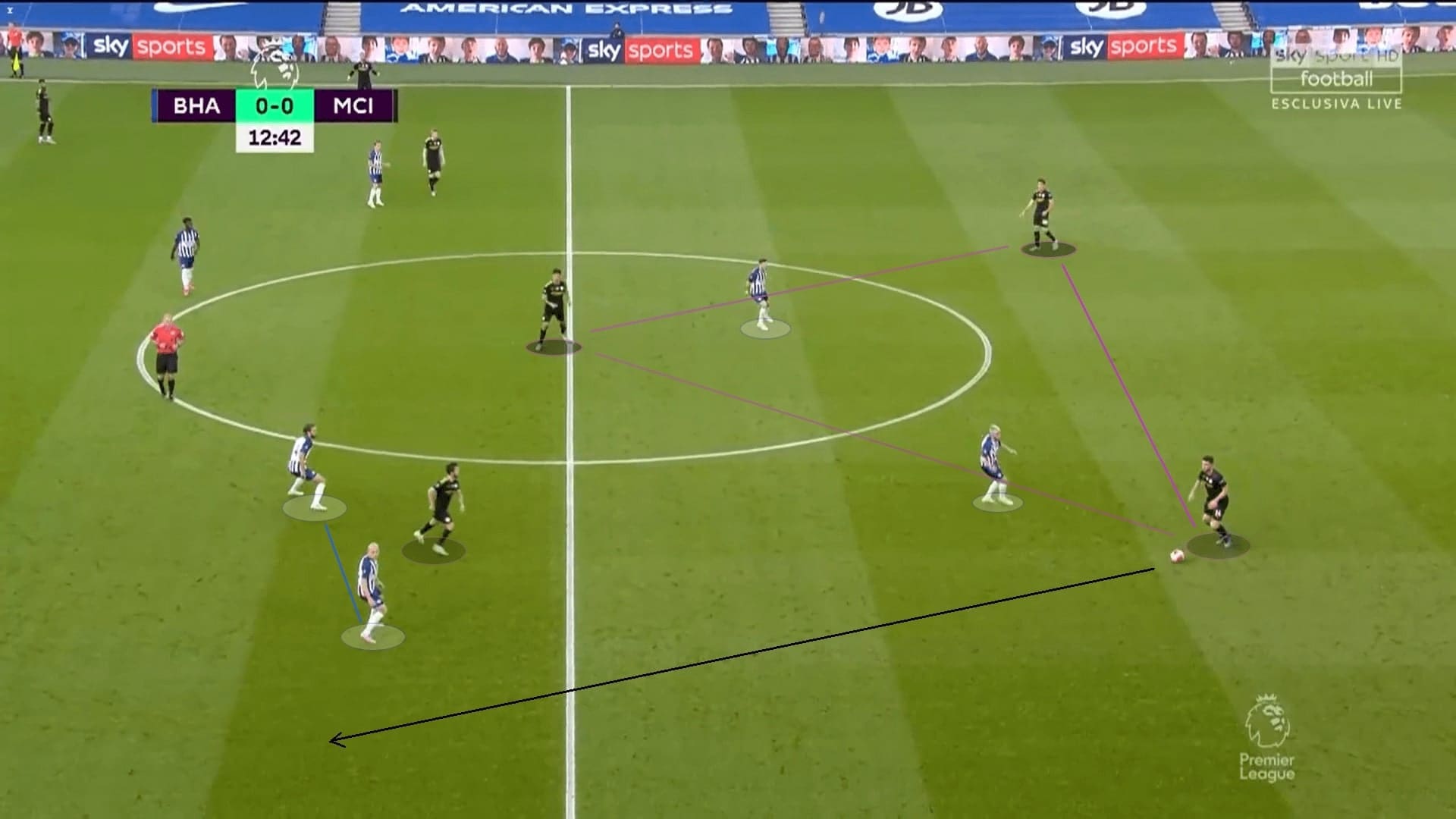
The rotations were commonly used at both flanks, as Mahrez sometimes took De Bruyne’s role and this was the case below. As mentioned, Brighton switched to a 4-3-3 after the water break. Responding to the change, Rodri dropped between the centre-backs, releasing the centre-backs to the half-spaces. This further strengthened the connection between the passer and the full-backs because of the closer distances.
Similar to the above concepts, the manipulation of lines was vital to create spaces for the first build-up layer. In this case, passing to García or Laporte were very fine for Rodri, as both were unmarked thanks to the services of the second layer.
By looking at Trossard and Connolly’s body shapes, the impacts of the dropping players were reflected. By staying between the lines, Mahrez and B. Silva drew the wide players at the first line and keeping them far from the centre-backs. Meanwhile, De Bruyne contributed by positioning himself behind the midfield and between two players – a use of positional superiority.
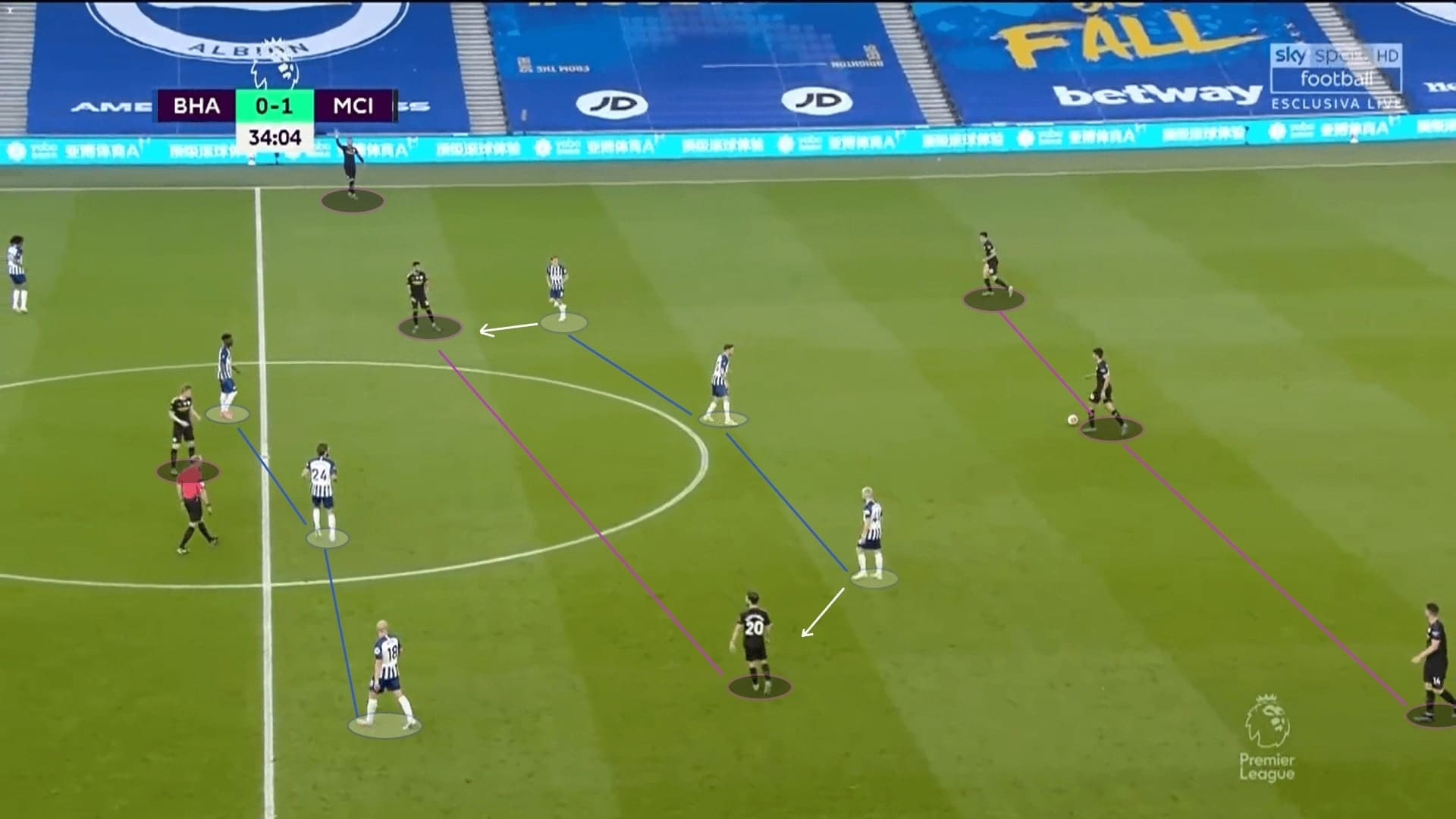
As a result, the full-backs were often the free player as the main men to develop the attacks. Sterling often moved to the half-spaces and between the lines, drawing the right-back narrow and opened the outer zone for Mendy.
Laporte released Mendy below. Note B. Silva’s positioning, this deep positioning was an echo on the behaviour to manipulate the second line. The Frenc left-back was an excellent crosser and a constant offensive threat in this game. At the centre, three players were available, and Gabriel Jesus was often here. The Brazilian striker was playing as a traditional striker and keep pushing the last line, while also being an option in these attacks.
Apart from the central options, Mahrez as the far-side winger would arrive at the box late for the heavy crosses. He would be on Bernardo’s blindside and it was impossible for the left-back to track his movements.
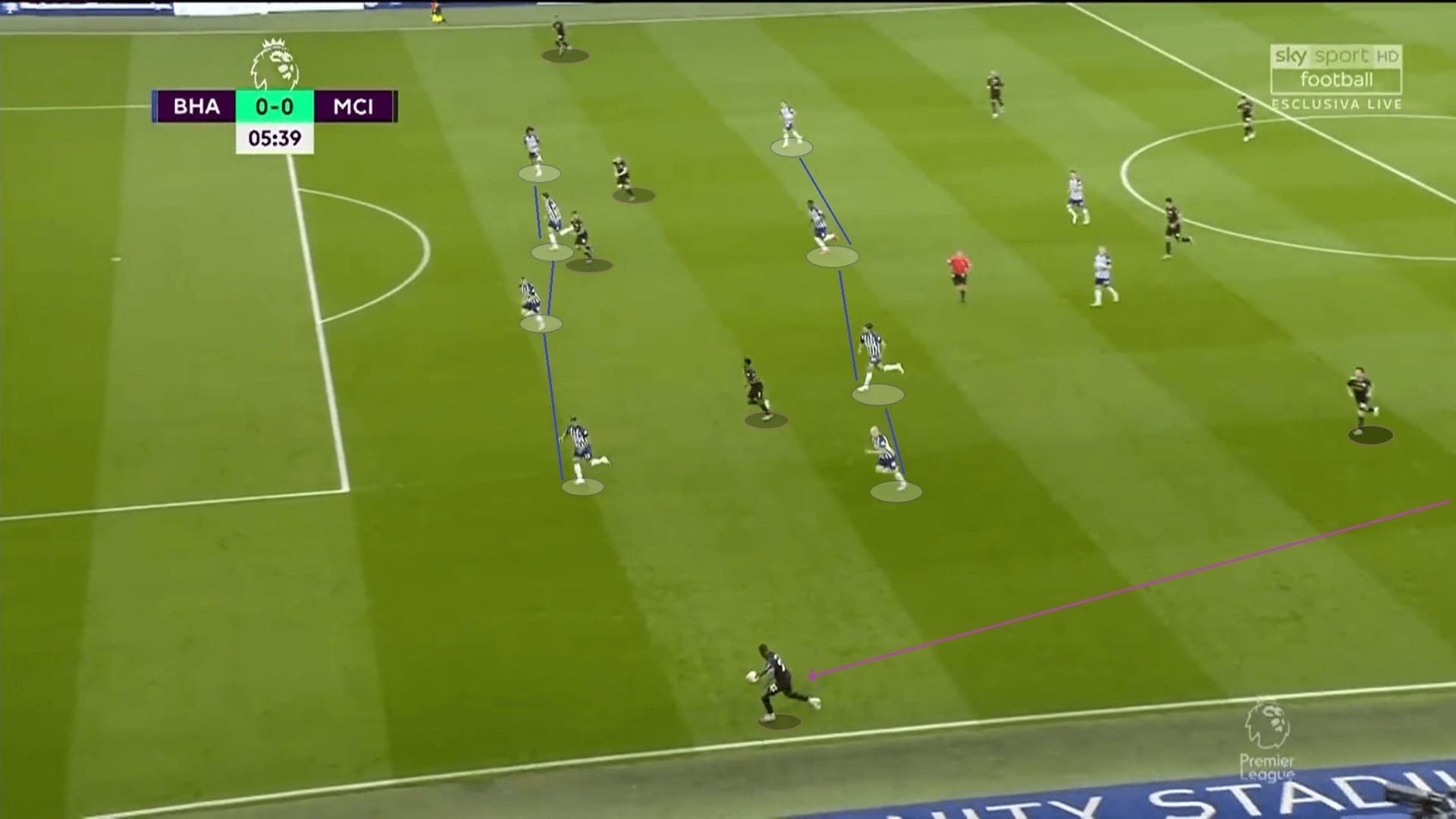
On the right, the situation was similar to Walker aggressively joining the attack and playing like a conventional winger. By an anti-clockwise set-up, De Bruyne appeared at the half-spaces and Mahrez left the outer zone for the right-back. We mentioned the late pressure of Brighton and here, De Bruyne was totally free to pick Walker because of this.
A tiny difference on this side was the traits of individuals. Walker possessed a better physical superiority than Mendy, hence why he needed space. Thanks to the line-breaking passes, the English right-back had a few times to go past Bernardo in the 1 v 1 situations and enter the final third.
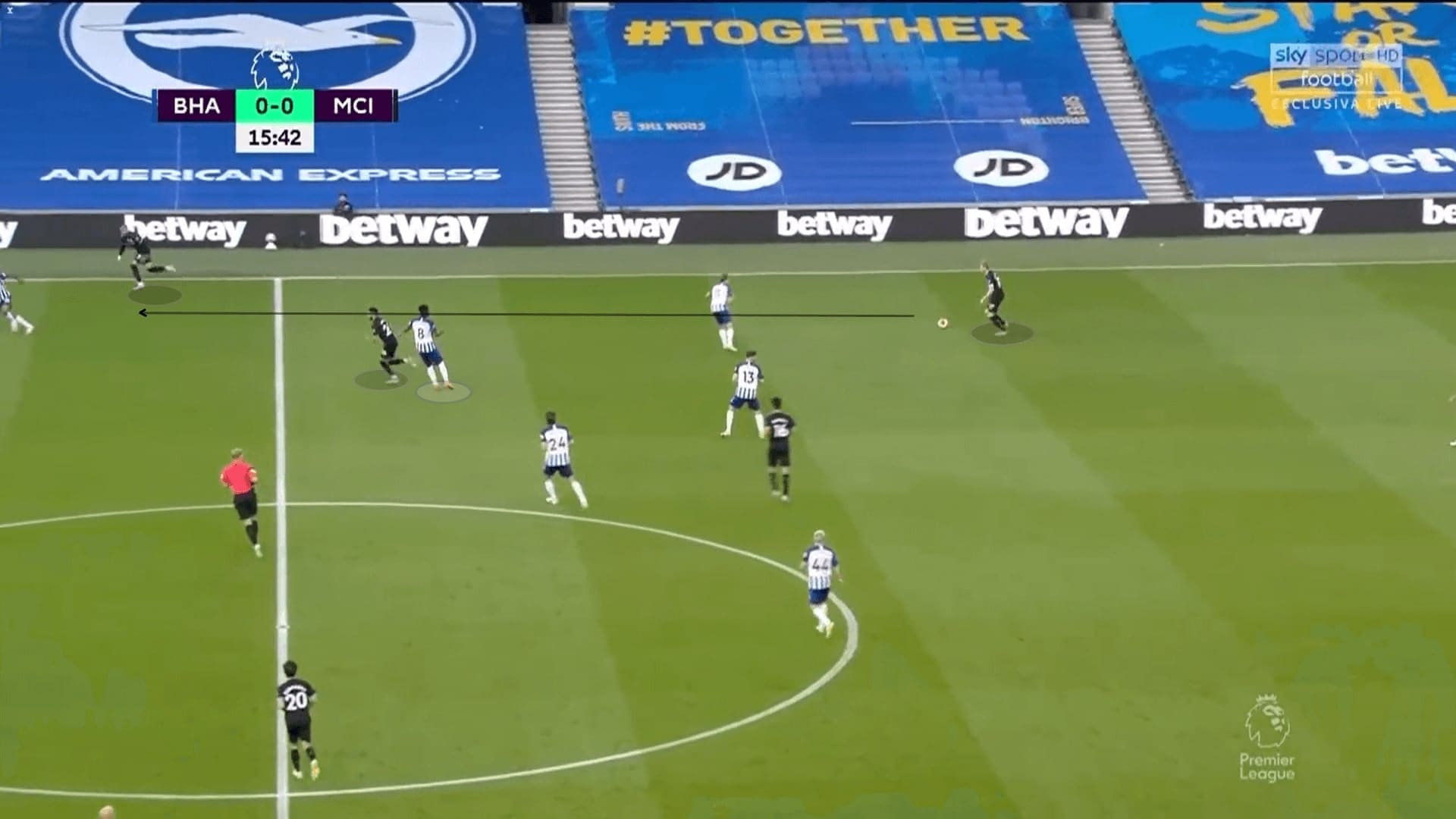
After Jesus was replaced by Foden, Sterling was the striker and playing as a “false-9”. This gave City another route to create the chances, especially the scoreboard was 0-4, and the defence was loose. The dropping movements of Sterling often dragged a centre-back out, creating a gap and spaces behind the defence for others to exploit.
An example can be seen here: Sterling took Lewis Dunk with him, the gap between the left-back and another centre-back was too big. Mahrez was the player to make a forward run and received the chipped ball from D. Silva, nearly scoring a goal.
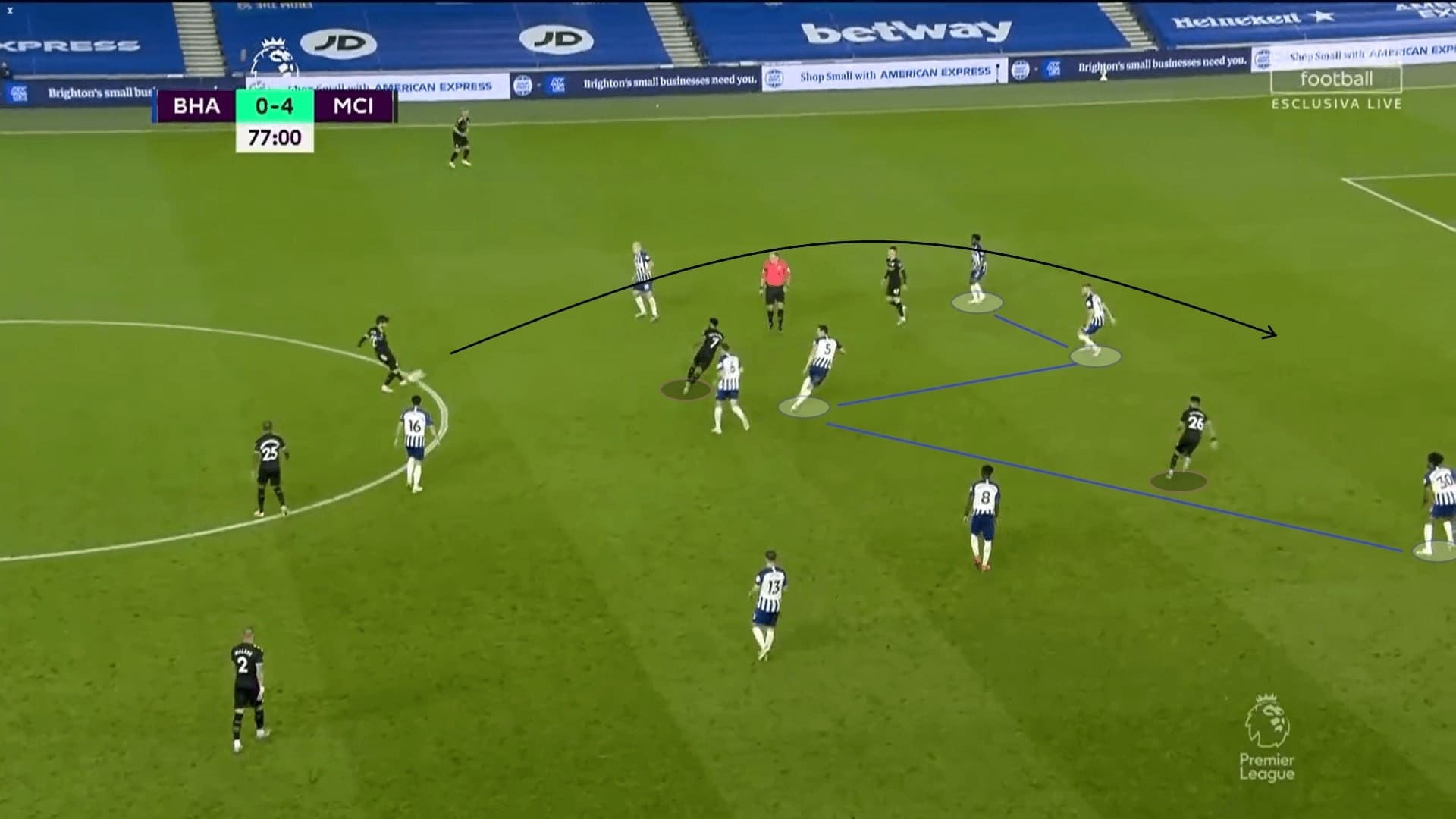
Transition phases and the excellent Jesus
In fact, City were a lot more dangerous in the transitions than in the offensive phases. Since Brighton were having less possession, the transitions would be great moments to hit the opponents, but Potter’s side failed to create something from it.
The reason was twofold. From Brighton’s perspective, the physicality was poor, and this hindered the development of a counter-attack. The midfield formed by Pröpper and Yves Bissouma was too soft, and the level of pressure resistance was weak.
This was reflected by stats – by looking at the duels graph of the game, Brighton were the underdog. Without the presence of a strong target man, no player was available to hold-up plays to initiate a counter-attack. Also, the duel win rates of Bissouma and Pröpper were too low, 38% and 30% respectively. City regained possession often by some strong and aggressive challenges and restarted the attack near the offensive third.
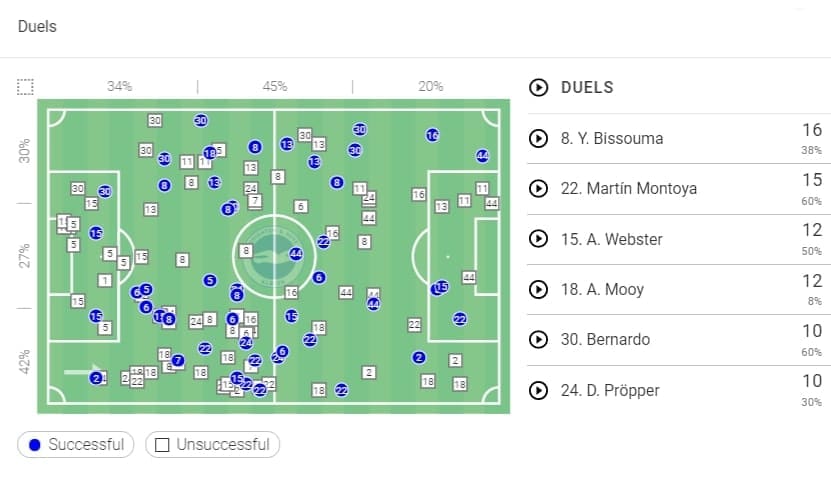
From City’s point of view, one player was particularly good in this game – Jesus. Offensively, the #9 of the Citizens contributed by scoring a goal and handed two assists. Defensively, the Brazilian player proved that he was one of the best counter-pressing strikers on the planet again.
The defensive efforts off the ball was a major influence on City’s domination. In this counter-pressing example, Pröpper was on the ball and looking for an option. Jesus, who was the highest positioned black shirt, did not instantaneously pressure the carrier. Instead, he kept his head up and perceived visual information around the ball, noticing the Mahrez and the accelerating De Bruyne.
The judgement of Jesus was perfect. There were three players to press potentially, and now he understood someone else could deal with Pröpper, so the Brazilian could either stick to Adam Webster or jump to Dunk. Jesus would have thought a step ahead, also perceiving the body shape of Pröpper would make the pass to Webster impossible. Therefore, the best decision was to sprint and intercept before the ball reaching Dunk, and he did it, which meant City countered the transition and started the attack high.
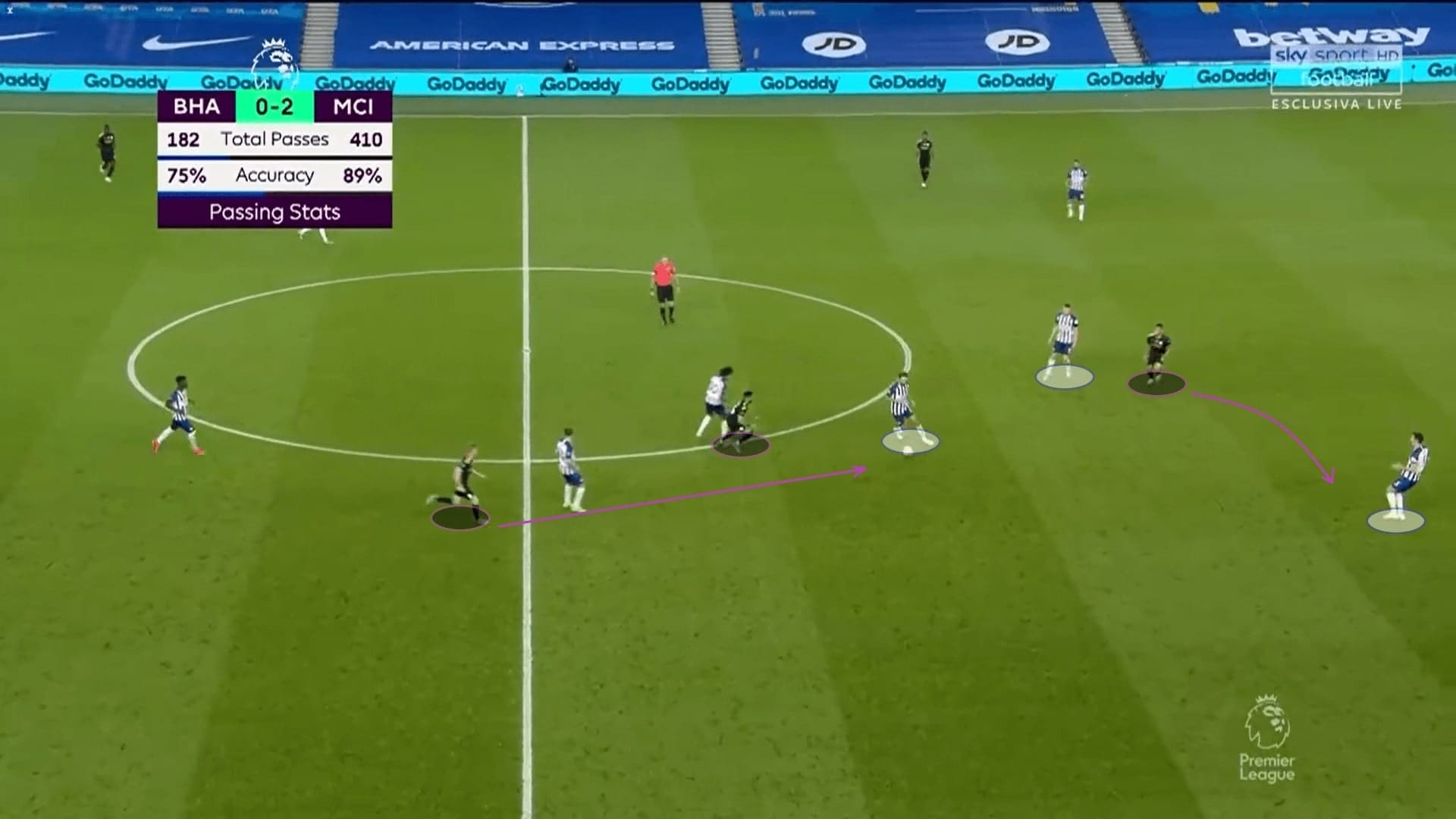
The second example was also showing the excellence of Jesus in the transition phases, the context was slightly different. City were pressing around the penalty box as Bissouma recovered possession from a dropped ball.
Jesus was smart as he was not counter-pressing until Bissouma passed the ball. Without a progressive target or a target man, the Malian international could only play to the defender to keep possession. Here, a curved run from Jesus shadowed the passer and open a narrow passing lane, and what was waiting was Mendy there.
The timing of this counter-press was excellent. If Jesus went to Bissouma early, the receiver would have too many spaces to play a long ball.
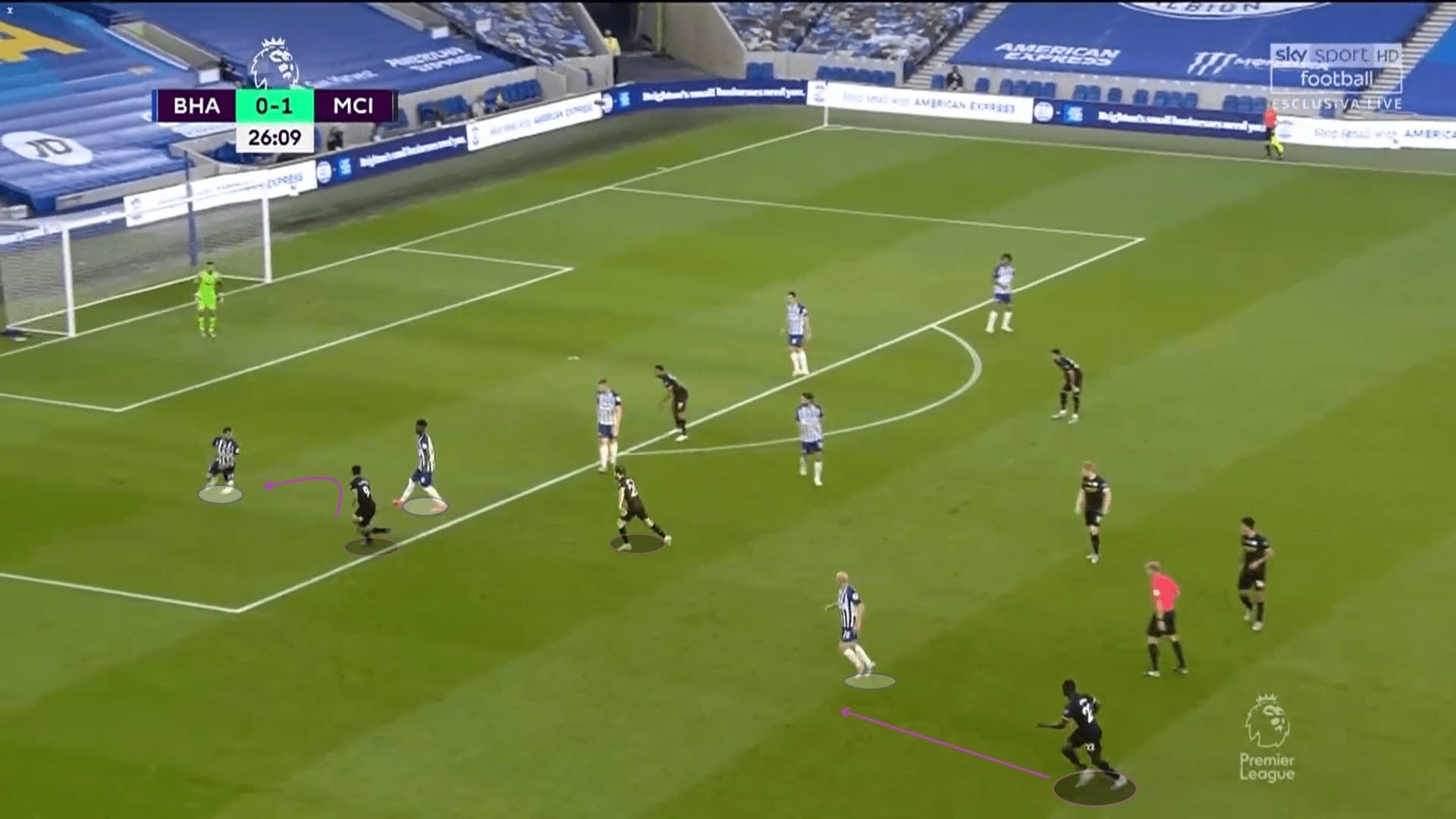
For some instances, Brighton reached the City half in offensive transitions and numerical equality at the frontline was achieved. It was a shame that the Seagulls failed to exploit these opportunities because of missing the best timings to pass. In fact, the spaces behind the City backline were huge, but Potter’s team did not try attacking these areas by the forward runs.
Below is an example where Connolly was carrying the ball forward. This was a 2 v 2 opportunity as another Seagull was staying at García’s blindside. However, the Brighton #44 spent too much time to correct the ball and the timing was gone.
From City’s perspective, Laporte’s calmness and composure were tremendous to keep the backline safe in these cases. The French centre-back tried delaying this attack by retreating and avoiding a challenge. This bought time for Mendy to track back and pressure Connolly from behind, which was a 2 v 1 situation and the Citizens regained possession.
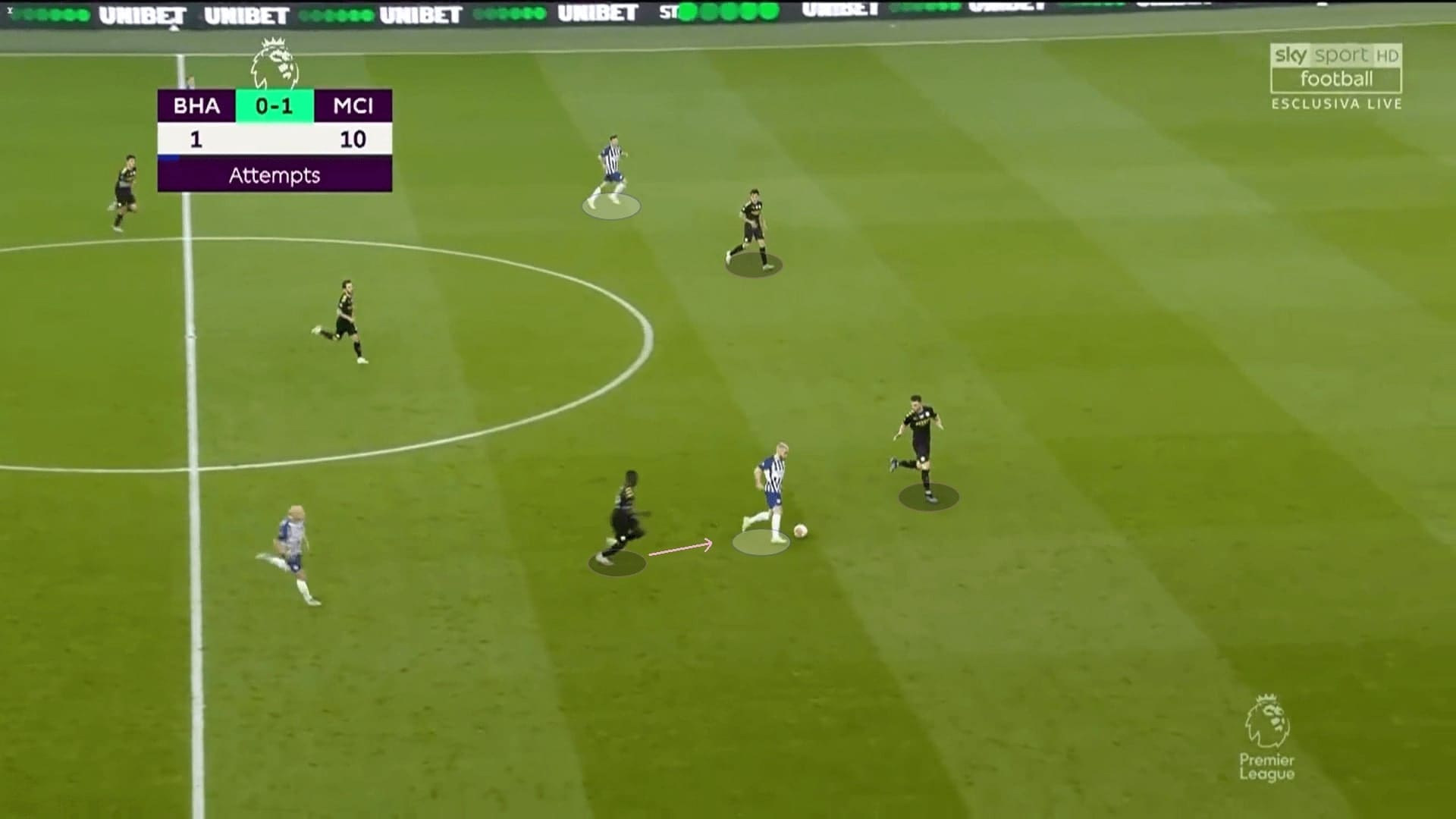
When regaining possession in the transitions, City were sharp to counter the counter-attacks. If the initial pass to create a shooting opportunity was unavailable, the wide players would be an option. With the strong passing vision of the team, the wide supporting man to support the attack could be found. This player could also stretch the defence while exploiting the spaces.
As an example, De Bruyne was charging forward in this counter-attack. Meanwhile, Walker supported with his electric pace and was released by the Belgian international. On other occasions, Sterling or Mahrez might hit a diagonal pass to the far side, similar concepts but different executions.
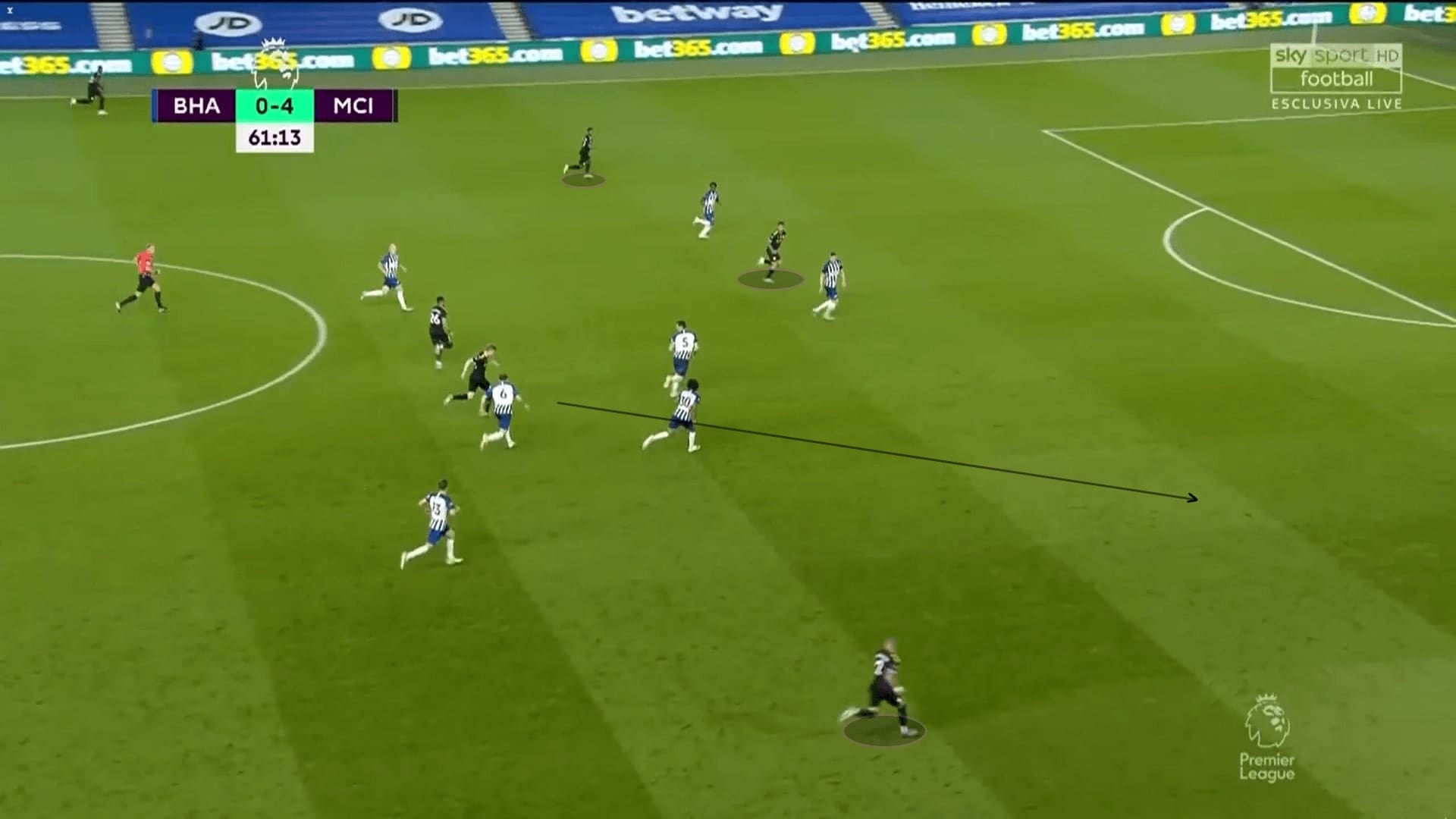
Final remarks
It was another quality display from City – the players were very sharp and the game was in control of Pep’s hand. Sterling scored another hat-trick and Jesus netted the 20th time of the season. The way the Citizens attacked and dominated the transitions were brilliant. For Brighton, the relegation battle continued with a six-point margin with Aston Villa, but Potter’s side were facing opponents out of the “Big six” and this was still optimistic.





Comments